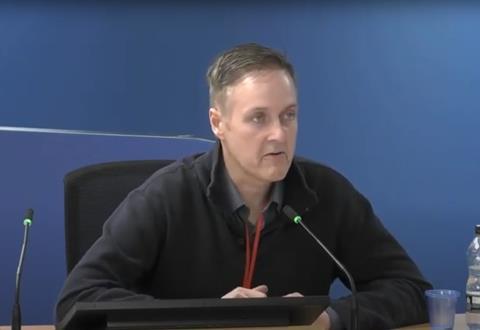Hearing told material used on tower became ‘raging inferno’ in first major fire test
It was “common knowledge” an insulation product installed as part of the refurbishment of Grenfell Tower had been using a fire test report for a different product, a former project manager at its manufacturer has admitted.
Kingspan technical project manager Ivor Meredith told Monday’s hearing of the Grenfell Inquiry that he was aware that the firm’s Kooltherm K15 insulation had been using a 2005 test report of an older version of the product, known by the firm as ‘old technology’ K15, and had flagged his concerns to senior staff.

Last month the firm withdrew the test reports for the product, which had been changed to a newer version dubbed ‘new technology’ K15 in 2006 – but by this time it had been selling the insulation on the market for more than 14 years.
The inquiry has already been shown a letter sent from Kingspan to the Building Research Establishment (BRE) on 23 October 2020 which admitted that tests of K15 carried out in 2005 and 2014 were “not sufficiently representative of the product currently sold into the market place”.
The letter went on to tell the BRE that “Kingspan is now of the view that there are sufficient differences to consider withdrawing this test report”.
Inquiry barrister Kate Grange QC asked Meredith: “Now, would you agree that, far from being something that Kingspan recently concluded, it was well known from September 2006 onwards that the 2005 test was undertaken with old technology K15? That’s right, isn’t it?”
Meredith answered: “I think that was common knowledge, yes.”
Meredith, who according to his witness statement was fired for gross misconduct in August 2015 after more than 16 years at the firm, admitted he had been aware that the fire performance of the new K15 product was different from the older version tested in 2005 and had flagged the issue “more than once” to his superiors, technical manager Philip Heath and UK technical director Malcolm Rochefort.
The ‘new technology’ K15 underwent its first major fire test on 20 December 2007, which Meredith said in a report at the time had become a “raging inferno” within 17 minutes of the test starting.
Meredith’s report said the insulation “was burning on its own steam and the BRE had to extinguish the test early because it was endangering setting fire to the laboratory”.
He said he was “shocked” by the result and added: “I sent a very animated report around to my superiors to make sure they were aware.”
Asked by Grange what the reaction of Heath and Rochefort had been, Meredith answered: “I can’t remember any real sort of shock”, adding: “I don’t think they were concerned in the same way as me.”
He told the inquiry that he had been criticised for “not being very positive about [Kingspan] products”.
The inquiry also heard how Kingspan had produced a marketing flyer after the 2005 test of the original ‘old technology’ K15 entitled: ‘What’s lurking behind your façade?’ in a bid to undermine its rivals.
The flyer claimed that the product had “not only been tested by the Building Research Establishment and awarded certification to BS 8414-1:2002, but it has also been assessed and approved in accordance with BR 135”.
Kingspan was later forced to withdraw the flyer after the BRE complained that it had not in fact approved the insulation and it had not been approved in accordance with BR 135, a criteria for assessing the fire performance of cladding systems.
Meredith said: “I’m very sorry for what’s happened, you know, so this is … you know, we should have perhaps been clearer in our marketing.”
>> Also read: Grenfell Inquiry digest | Module one: How experts blamed key players for ‘shambles’
Last week, the inquiry heard how Celotex had rebranded its FR5000 insulation product as a new product which was safe for use in buildings above 18m in order to compete with Kingspan’s K15 insulation, which was the market leader for insulation in high rise buildings at the time.
Former Celotex product manager John Roper told the inquiry how he and his colleagues had attempted to obtain the test data for K15 but had found it “almost impossible”, despite rarely encountering problems when attempting to find data on other products.
The second module of the inquiry is focusing on the role of the refurbishment’s materials in the 2017 fire at Grenfell tower, which killed 72 people.
The inquiry continues.
















1 Readers' comment